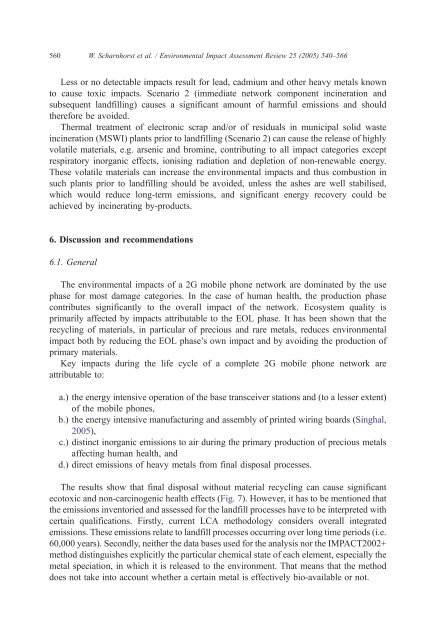The end of life treatment of second generation mobile phone ... - Empa
The end of life treatment of second generation mobile phone ... - Empa
The end of life treatment of second generation mobile phone ... - Empa
You also want an ePaper? Increase the reach of your titles
YUMPU automatically turns print PDFs into web optimized ePapers that Google loves.
560W. Scharnhorst et al. / Environmental Impact Assessment Review 25 (2005) 540–566Less or no detectable impacts result for lead, cadmium and other heavy metals knownto cause toxic impacts. Scenario 2 (immediate network component incineration andsubsequent landfilling) causes a significant amount <strong>of</strong> harmful emissions and shouldtherefore be avoided.<strong>The</strong>rmal <strong>treatment</strong> <strong>of</strong> electronic scrap and/or <strong>of</strong> residuals in municipal solid wasteincineration (MSWI) plants prior to landfilling (Scenario 2) can cause the release <strong>of</strong> highlyvolatile materials, e.g. arsenic and bromine, contributing to all impact categories exceptrespiratory inorganic effects, ionising radiation and depletion <strong>of</strong> non-renewable energy.<strong>The</strong>se volatile materials can increase the environmental impacts and thus combustion insuch plants prior to landfilling should be avoided, unless the ashes are well stabilised,which would reduce long-term emissions, and significant energy recovery could beachieved by incinerating by-products.6. Discussion and recomm<strong>end</strong>ations6.1. General<strong>The</strong> environmental impacts <strong>of</strong> a 2G <strong>mobile</strong> <strong>phone</strong> network are dominated by the usephase for most damage categories. In the case <strong>of</strong> human health, the production phasecontributes significantly to the overall impact <strong>of</strong> the network. Ecosystem quality isprimarily affected by impacts attributable to the EOL phase. It has been shown that therecycling <strong>of</strong> materials, in particular <strong>of</strong> precious and rare metals, reduces environmentalimpact both by reducing the EOL phase’s own impact and by avoiding the production <strong>of</strong>primary materials.Key impacts during the <strong>life</strong> cycle <strong>of</strong> a complete 2G <strong>mobile</strong> <strong>phone</strong> network areattributable to:a.) the energy intensive operation <strong>of</strong> the base transceiver stations and (to a lesser extent)<strong>of</strong> the <strong>mobile</strong> <strong>phone</strong>s,b.) the energy intensive manufacturing and assembly <strong>of</strong> printed wiring boards (Singhal,2005),c.) distinct inorganic emissions to air during the primary production <strong>of</strong> precious metalsaffecting human health, andd.) direct emissions <strong>of</strong> heavy metals from final disposal processes.<strong>The</strong> results show that final disposal without material recycling can cause significantecotoxic and non-carcinogenic health effects (Fig. 7). However, it has to be mentioned thatthe emissions inventoried and assessed for the landfill processes have to be interpreted withcertain qualifications. Firstly, current LCA methodology considers overall integratedemissions. <strong>The</strong>se emissions relate to landfill processes occurring over long time periods (i.e.60,000 years). Secondly, neither the data bases used for the analysis nor the IMPACT2002+method distinguishes explicitly the particular chemical state <strong>of</strong> each element, especially themetal speciation, in which it is released to the environment. That means that the methoddoes not take into account whether a certain metal is effectively bio-available or not.
















